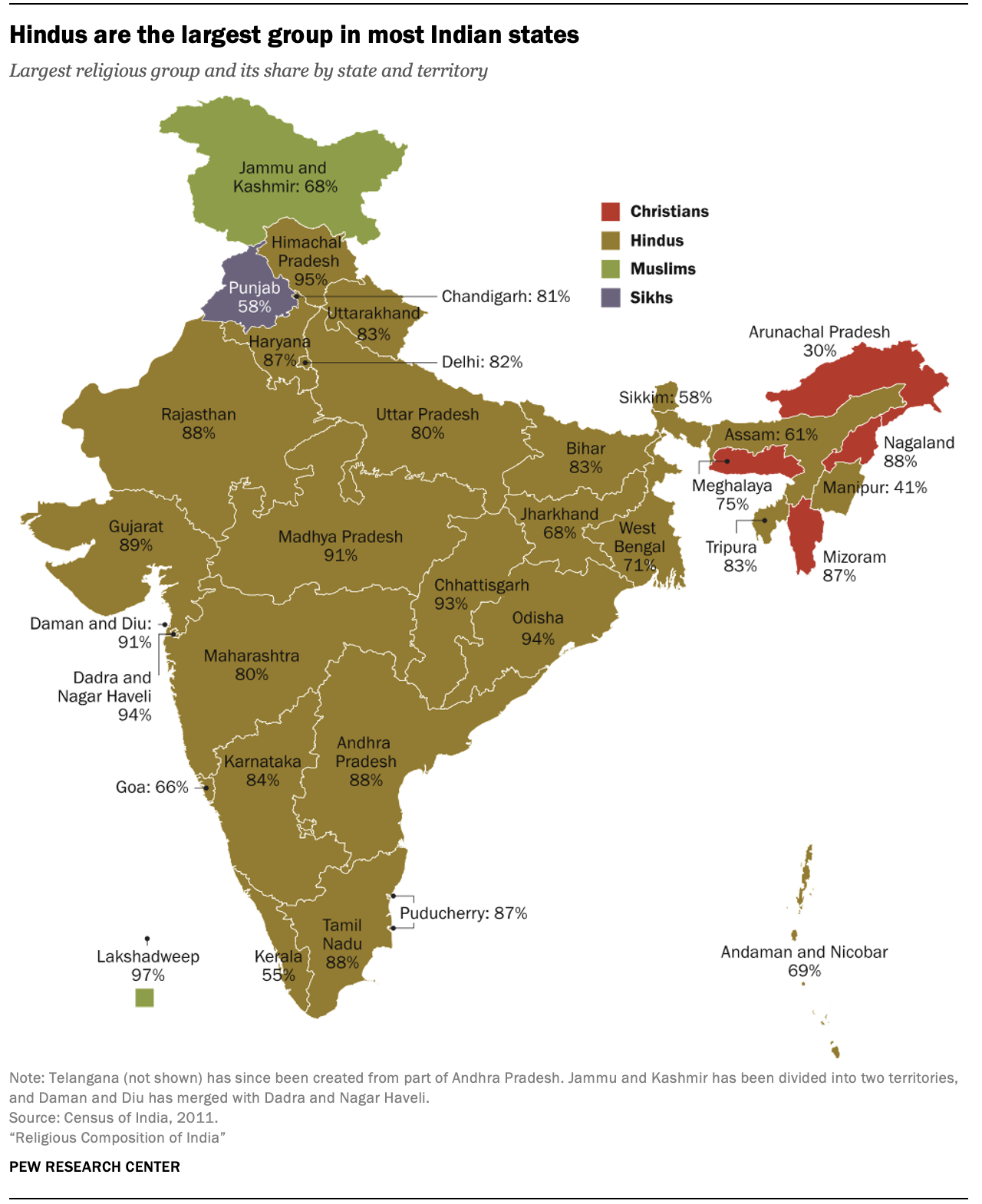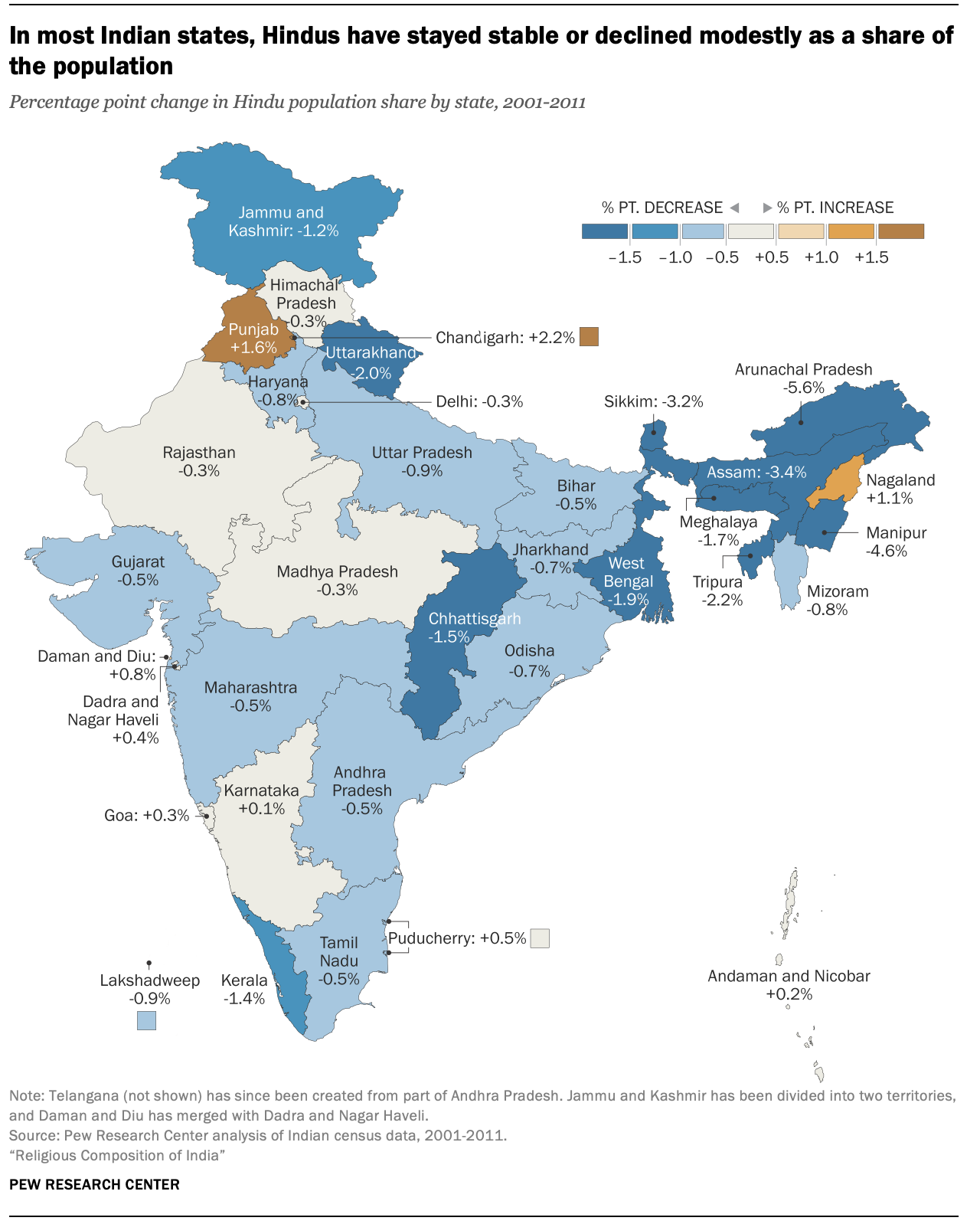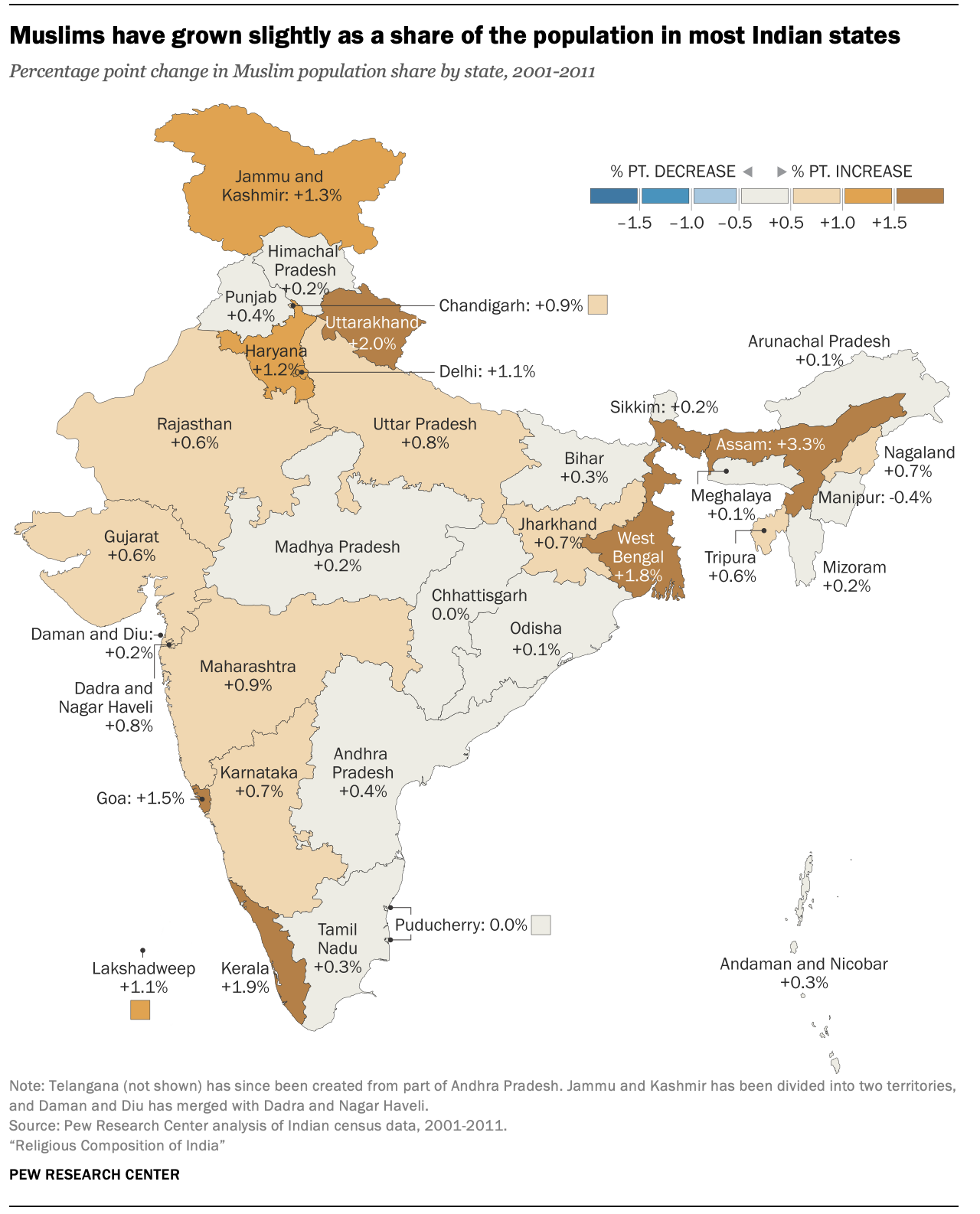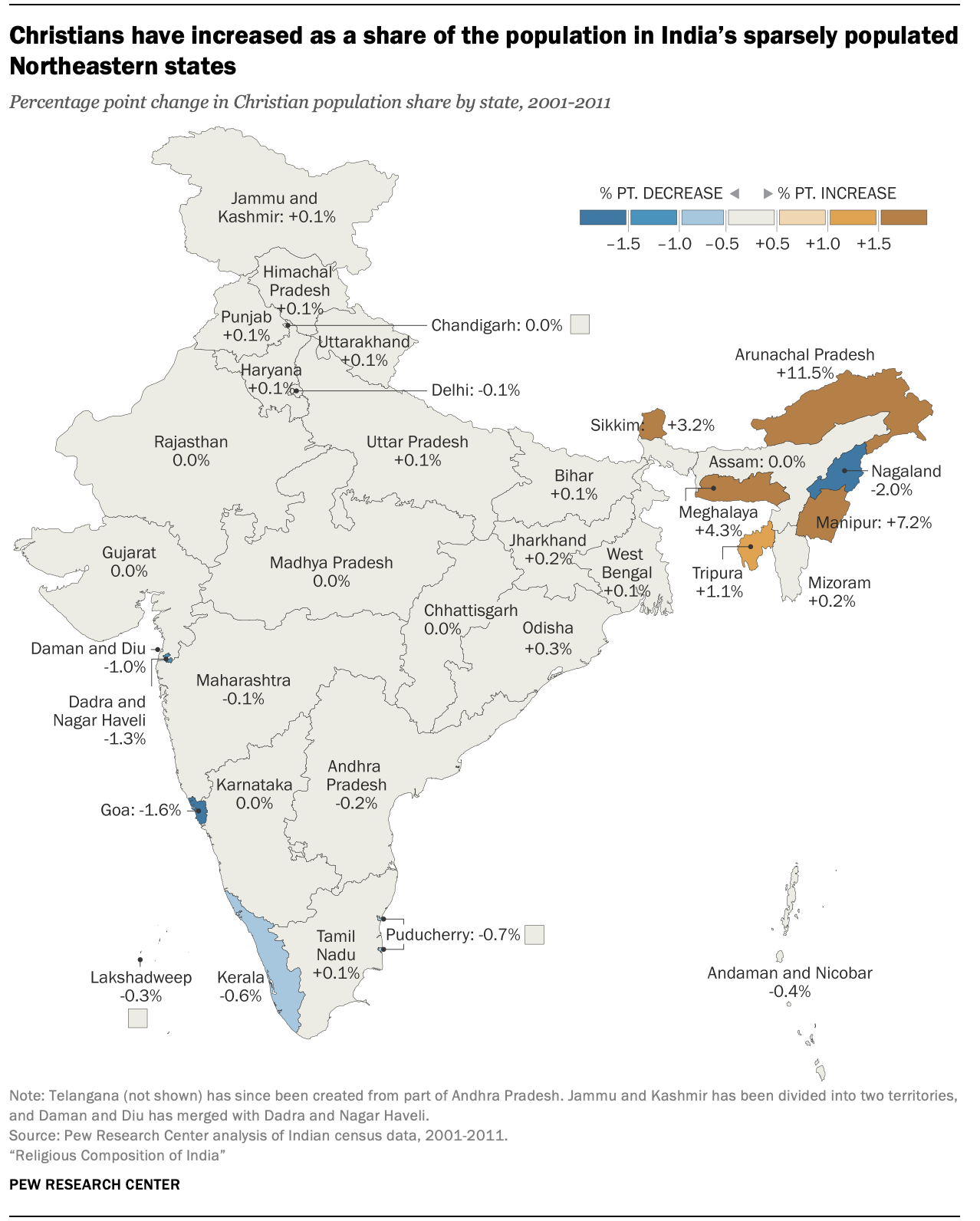As is the case in most countries, population density varies widely across India. The most populous state, Uttar Pradesh, recorded close to 200 million (20 crore) inhabitants in the 2011 census, while the southern archipelago of Lakshadweep had fewer than 100,000 (1,00,000 in India’s number system). Adherents of religious groups also are not evenly distributed across the country.
A note on large numbers
India uses a number system that differs from the international number system. This report presents numbers in the international system and, in parentheses, the Indian system. The Indian number system uses units such as lakhs and crores and places commas at different intervals than the international system. Some examples of equivalents:
International number system vs. Indian number system
One hundred thousand (100,000) = 1 lakh (1,00,000)
One million (1,000,000) = 10 lakh (10,00,000)
Ten million (10,000,000) = 1 crore (1,00,00,000)
As a result, religious groups live in a wide variety of local contexts in ways that are not apparent in the national patterns presented above. In some cases, many million (tens of lakh) members of a certain group live as a religious minority in a very large state. And in others, a much smaller number of adherents form a large majority in one of India’s smaller states.
As of the 2011 census, Hindus were a majority in 28 of India’s 35 states and union territories, including all of the country’s most populous states: Uttar Pradesh (total population 200 million, or 20 crore), Maharashtra (112 million, or 11.2 crore), Bihar (104 million, or 10.4 crore) and West Bengal (91 million, or 9.1 crore).12
Muslims are the majority in the small tropical archipelago of Lakshadweep (total population 60,000) and in Jammu and Kashmir (13 million, or 130 lakh), on the border with Pakistan. Jammu and Kashmir was carved out as a state separate from both India and Pakistan during Partition, but in 2019 was stripped of its semi-autonomous status and reorganized into territories to be administered by India directly. Jammu and Kashmir was home to about 8.6 million (86 lakh) Muslims as of the 2011 census, making it the Indian state with the seventh-largest Muslim population.

Christians are a majority in Nagaland (total population 2 million, or 20 lakh), Mizoram (1 million, or 10 lakh) and Meghalaya (3 million, or 30 lakh) – three small states in a sparsely populated, fertile mountain range in India’s Northeast. Smaller numbers of Christians live in any of those states than live as religious minorities in the much larger states of Kerala (33 million, or 3.3 crore) and Tamil Nadu (72 million, or 7.2 crore).
Sikhs are the largest group in Punjab (total population 28 million, or 2.8 crore), which is the only state where a religious group other than Hindus, Muslims or Christians forms a majority. The populations of two states, Arunachal Pradesh (1.4 million, or 14 lakh) and Manipur (3 million, or 30 lakh), are religiously diverse, with substantial shares of several religious groups and none approaching a majority. In Arunachal Pradesh, for example, where 39% of the population falls into the “other” category of smaller religions, many people identify as Donyi-Polo. Meanwhile, in the state of Sikkim, which borders Tibet, 27% are Buddhists.
Though the population shares discussed in this chapter are as of the last Indian census conducted in 2011, state majorities are generally large enough that they would not be expected to move below 50% in a single decade.
When it comes to total numbers, the largest populations of both Hindus (159 million, or 15.9 crore) and Muslims (38 million, or 3.8 crore) live in Uttar Pradesh, accounting for 16% and 22% of India’s Hindus and Muslims, respectively. The greatest number of Christians live in Kerala (6 million, or 60 lakh, which is about 22% of the country’s Christians). Most Sikhs live in Punjab (16 million, or 1.6 crore – 77% of Indian Sikhs).
Buddhists are most often found in Maharashtra on India’s western coast (6.5 million, or 65 lakh), making up 77% of India’s Buddhists. Maharashtra, India’s second most populous state – which includes Mumbai, India’s largest city – is also the state with the largest number of Jains (1.4 million, or 14 lakh – 31% of Indian Jains).

At the state level, religious distributions were relatively stable in the most recent census decade
While most of this report examines changes in religious composition on a national level since the first post-independence census of 1951, this section focuses on developments within states between the censuses of 2001 and 2011.
India’s domestic borders were largely stable across its 35 states and union territories during that decade, making it possible to track state-level changes in the relative sizes of religious groups. Prior to 2001, the boundaries of states and territories shifted frequently, making it difficult to draw comparisons from one census to the next. (See previous sidebar for more on India’s shifting geography.)
Overall, there was relatively little change in the religious composition of states between 2001 and 2011, particularly within the more populous ones, even as populations soared in almost every state. Within states, religious groups’ shares rarely rose or fell by more than 3 percentage points, and in most cases, they did not change by more than a small fraction of 1%.
This was particularly true for Hindus, who generally held steady or declined modestly as a share of state populations between 2001 and 2011. For example, the share of Hindus in Uttar Pradesh declined by 0.9 percentage points during the decade, and the percentage of Hindus in Maharashtra dropped by 0.5 points. One exception to this pattern was Punjab, where the share of Hindus rose by 1.6 percentage points.

Muslims usually maintained their population shares within states or increased them slightly between 2001 and 2011. For instance, Muslims grew as a share of West Bengal’s population by 1.8 percentage points, and the Muslim majority in Jammu and Kashmir grew by 1.3 points. The only state in which the Muslim share dropped was Manipur, with a 0.4-point decrease.

Some of the most substantial changes in religious groups’ population shares were in India’s isolated Northeast
Christians experienced significant changes to their population shares only in India’s Northeast. With the exception of Assam (population 31 million, or 3.1 crore), the Northeastern states have very small populations – ranging from 610,000 (Indian system: 6,10,000) in Sikkim to 3.7 million (37 lakh) in Tripura – so even minor fluctuations in religious groups’ counts can substantially affect their relative sizes. Indeed, changes in overall religious composition were most pronounced in this mountainous region, which is wedged in a panhandle bordering China, Bangladesh, Myanmar, Bhutan and Nepal and is largely isolated from the rest of India.
Christians, who make up a larger share of the population in this region than they do nationally, grew as a percentage of several states between 2001 and 2011. The share of Christians rose in Arunachal Pradesh by 12 percentage points (to 30%), in Manipur by 7 points (to 41%), in Meghalaya by 4 points (to 75%) and in Sikkim by 3 points (to 10%). The share of Christians in Nagaland fell slightly, though they remained in the overwhelming majority.
Hindus also had their biggest percentage point changes in the sparsely populated Northeast, declining by 3 points or more in Arunachal Pradesh (down 6 percentage points to 29%), Manipur (-5 points to 41%), Assam (-3 points to 61%) and Sikkim (-3 points to 58%). Muslims, too, experienced their biggest change in the Northeast, in Assam (+3 points to 34%).

Few large states experienced substantial changes in their religious landscapes
Besides Assam, only four other states with a population of at least 10 million (1 crore) had any religious groups that experienced changes of 2 percentage points or more in their share of the state population between 2001 and 2011.
- In West Bengal (population 91 million, or 9.1 crore), the Hindu share decreased by 2 percentage points to 71%, and Muslims increased 2 points to 27%.
- In Punjab (28 million, or 2.8 crore), the Sikh majority decreased by 2 points to 58%.
- In Kerala (33 million, or 3.3 crore), the Muslim share increased by 2 points to 27%.
- And in Uttarakhand (10 million, or 1 crore), the Hindu share decreased by 2 percentage points to 83%, while the Muslim share increased by 2 points to 14%.
All three of India’s largest religious groups grew in total number in nearly every state
In terms of absolute numbers, Hindus, Muslims and Christians grew in virtually every Indian state. The number of Hindus decreased slightly (by about 1,500) in only one state, Christian-majority Mizoram, while the number of Christians declined by more than 50,000 in both Nagaland and Andhra Pradesh. The total number of Muslims did not discernably decrease in any state during this decade.
Hindus experienced their largest population growth by number in Uttar Pradesh, India’s most populous state – increasing by 25 million (2.5 crore) to 159 million, or 15.9 crore – followed by Bihar, whose Hindu population rose by 17 million (1.7 crore) to 86 million, or 8.6 crore. Both Uttar Pradesh and Bihar have higher than average rates of poverty and, relatedly, exceptionally high fertility rates.
The Muslim population also had its largest increase in Uttar Pradesh, increasing by 8 million (80 lakh) to 38 million, or 3.8 crore, followed by West Bengal, up by 4 million (40 lakh) to 25 million, or 2.5 crore. West Bengal has poverty and fertility rates that are slightly lower than average.
The Christian population grew the most in Tamil Nadu, increasing by 600,000 (6,00,000 by India’s system) to 4 million, or 40 lakh, and Meghalaya, also by 600,000 (6,00,000), to 2.2 million, or 22 lakh. Tamil Nadu, in the far South, has a low fertility rate, while Meghalaya, in the Northeast, has high fertility rates.


